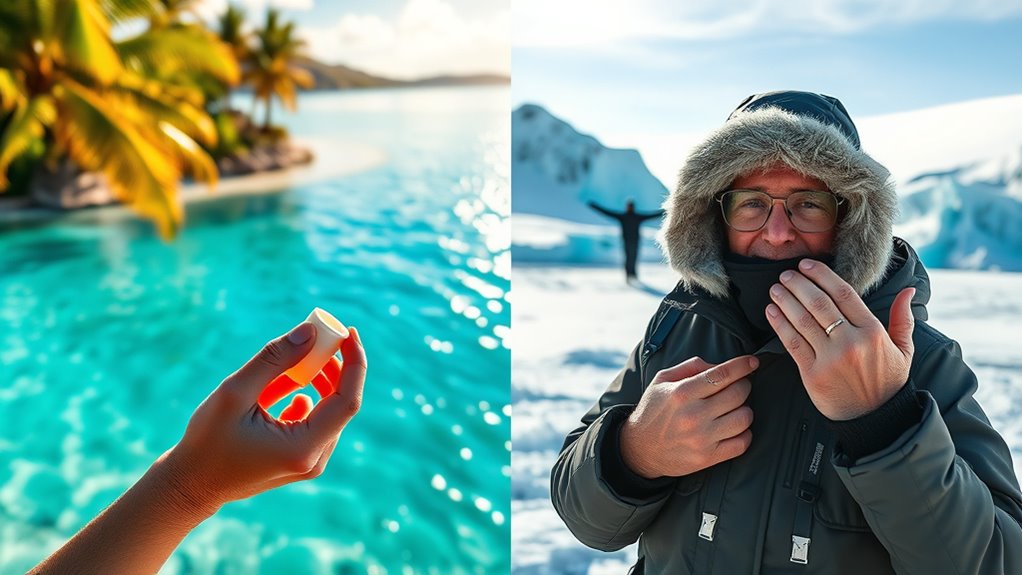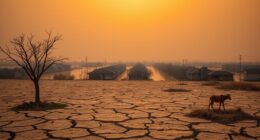In tropical climates, you need lightweight, SPF-rich lip balms to protect against sun damage and dehydration caused by heat and humidity. In cold, Arctic environments, switch to thick, emollient balms with ingredients like petrolatum or lanolin to seal in moisture and guard against biting winds. Remember, hydration plays a key role in both settings. Adjust your lip care routine accordingly, and if you stay tuned, you’ll discover more tips to keep your lips healthy no matter the climate.
Key Takeaways
- Tropical climates require SPF-rich, hydrating lip balms with ingredients like shea butter to combat dehydration and sun damage.
- Cold Arctic environments demand thick, emollient balms with petrolatum or lanolin to seal in moisture and protect against wind.
- In hot, humid weather, lips tend to feel sticky; hydration and barrier protection minimize moisture loss and prevent chapping.
- Cold, dry conditions cause lips to crack; frequent application of protective balms and physical barriers like scarves are essential.
- Adjust lip care routines seasonally, using lightweight, sun-protective products in tropical areas and intensive moisturizers in Arctic climates.

Have you ever noticed how your lips react differently depending on the weather? In hot, humid climates, your lips might feel sticky or greasy, while in cold, dry environments, they can become chapped and cracked. These reactions are a clear sign that your lips need different care strategies depending on the climate. When you’re in a tropical setting, the high temperatures and intense sun can quickly dehydrate your lips, making lip hydration a priority. You might think you’re doing enough with regular lip balm, but in tropical weather, it’s essential to use products that provide a barrier against moisture loss and offer sun protection. Look for lip balms with SPF and ingredients like shea butter or beeswax, which create a protective film to lock in moisture. Staying hydrated by drinking plenty of water is also vital because dehydration worsens dryness and chapping. Remember, your lips are especially vulnerable because they lack oil glands, so weather adaptation is key to maintaining healthy lips in a tropical climate.
Conversely, in Arctic or cold environments, your lips face a different challenge. The low temperatures and biting winds strip moisture from your lips rapidly, leading to cracking and bleeding. Here, your focus should be on restoring lip hydration and creating a protective barrier against harsh elements. Use thick, emollient lip balms that contain ingredients like petrolatum or lanolin, which form a seal to prevent moisture from escaping. Avoid licking your lips, as saliva evaporates quickly, leaving your lips even drier. Instead, apply balm frequently, especially before stepping outside or after exposure to wind. Cover your lips with a scarf or a face mask to shield them from the cold wind and prevent further moisture loss. Proper weather adaptation in cold climates involves not just moisturizing but also physically shielding your lips from the elements. Hydration from within is equally important, so ensure you’re drinking enough water to help your body and lips stay moist.
In both tropical and Arctic climates, understanding how weather affects your lips guides your care routine. The main goal is to adjust your lip hydration strategies according to the environment. Whether it’s using SPF-infused balms in the heat or thick, barrier-forming balms in the cold, adapting your approach helps protect your lips and keeps them healthy. Recognizing the signs your lips give you—like dryness, cracking, or peeling—allows you to respond promptly. By paying attention to how your lips react and practicing weather-specific care, you can maintain soft, smooth lips no matter where you are.
Frequently Asked Questions
How Does Humidity Impact Lip Hydration in Different Climates?
Humidity effects play a big role in lip hydration, and you’ll notice differences depending on your climate. In humid environments, high moisture levels help keep your lips hydrated naturally, reducing chapping. Conversely, in dry conditions, low humidity causes moisture to evaporate quickly, leading to dry, cracked lips. To protect your lips in varying climates, use hydrating balms and stay mindful of humidity effects to maintain healthy, moisturized lips year-round.
Are There Specific Ingredients Better Suited for Tropical vs. Arctic Lip Care?
When choosing lip care ingredients, you should consider ingredients compatibility and formulation preferences for different climates. In tropical environments, look for hydrating, lightweight formulas with ingredients like aloe vera or glycerin that withstand humidity. For Arctic conditions, opt for richer, occlusive ingredients such as beeswax or shea butter to protect against cold, dry air. Tailoring your lip balm’s formulation guarantees ideal protection and hydration no matter the climate.
Can Climate Change Alter Long-Term Lip Health Strategies?
It’s a coincidence that climate change can considerably influence your long-term lip health strategies. As temperatures shift and weather patterns become unpredictable, you’ll need to adapt your approach. Climate adaptation means choosing more effective, long-term moisturizing methods suited for evolving conditions. Staying flexible ensures your lips remain protected, regardless of new environmental challenges. By proactively adjusting your lip care routine, you safeguard your lips against future climate impacts and maintain their health over time.
How Often Should I Update My Lip Care Routine With Seasonal Changes?
You should update your lip care routine with seasonal adjustments regularly. In colder months, switch to a richer lip moisturizer to combat dryness, and in warmer months, opt for lighter formulas. Pay attention to changes in weather and your lips’ condition. Reapplying your lip moisturizer throughout the day helps maintain hydration. Adjusting your routine guarantees your lips stay protected, healthy, and moisturized year-round, no matter the season.
Are There Natural Remedies Effective Across All Climates for Chapped Lips?
Natural remedies can offer universal effectiveness for chapped lips, regardless of climate. You might use honey for its healing properties, coconut oil for deep hydration, or aloe vera to soothe. These remedies work across tropical and arctic conditions by locking in moisture and providing essential nutrients. Incorporate them into your routine regularly to keep lips healthy and protected, no matter where you are or how the weather changes.
Conclusion
Understanding how different climates impact your lips helps you choose the right care. In tropical environments, you might need extra hydration and SPF to combat sun exposure, while in arctic conditions, sealing in moisture and protection from cold winds become vital. Think of your lips like a plant: they need tailored care based on their environment to thrive. By adjusting your routine, you guarantee your lips stay healthy and protected, no matter where you are.










